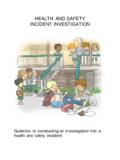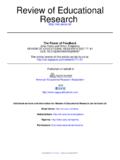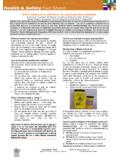Transcription of Data literacy framework - Education
1 Data use is plannedData builds understandingData literacy frameworkData informs our practiceOur use of data is planned to meet the needs of our whole community through: alignment to explicit improvement agenda collaborative development of a data plan, which for schools is done in accordance with the joint statements between the department and the Queensland Teachers Union understanding all of our children and transformation from information to informed practice takes place in context through: knowing our community knowing the curriculum and pedagogy adopting curious, open-minded dispositions with critical and creative thinking identifying appropriate measures analysing and discussing data learning together through each stage of the inquiry cycle understanding is used in an inquiry approach to challenge our assumptions and inform decisions and actions.
2 We use data to: understand what is working well, for whom set targets for improvement by comparison to relevant data sets decide on actions to address problems of practice monitor the impact of what we are doing to improve learning and wellbeing of children and students, school improvement and ECEC quality focussedEthicalCollaborativePurposefulDa ta-informed practice Developing our data literacy supports us to use our measures to bring precision to our and responding to data ethically strengthens our contribution to A great start for all children and the State Schools Improvement Strategy Every student literacy is developed in the context of our everyday work of making a difference to learning and wellbeing for all children and data literacy framework
3 Provides guidance on using data to support learning and wellbeing for children and students, as well as early childhood Education and care (ECEC) quality improvement and school improvement. It also serves as a support for developing the data literacy of educators, teachers and leaders in ECEC and literacy refers to the knowledge, skills and dispositions to use data ethically to inform policies, decisions and literacy involves: managing and securing data accessing and generating data evaluating and interpreting data communicating with practice is enabled by taking a purposeful, collaborative, solution focussed, ethical and inclusive approach to our engagement with both using, and learning about the use of, data.
4 Queensland state schools commit to providing opportunities for every Aboriginal and Torres Strait Islander child and student to achieve success by walking with First Nations people to teach and celebrate local histories and data plansAccessing a range of data setsGuiding questions for data-informed practiceDeveloping data literacyResourcesA data plan, is developed collaboratively, and indicates how data will inform teaching practice, school improvement and ECEC quality improvement. The data plan outlines the data activities that take place, by defining: which data, when, by whom how data is stored, shared, accessed, presented, tracked, monitored and plans also inform: resourcing capability plans enable pre-approval of data activities for data more details about data use in schools refer to the joint statements: The purpose and use of data in Queensland schools (2021) and National Assessment Program literacy and Numeracy ( naplan ) (2018).
5 In the context of our everyday work educators, teachers and leaders (in ECEC and schools) use qualitative and quantitative data, in combinations related to: progress in learning and student academic achievement from formative, summative and diagnostic sources wellbeing from daily interactions, community insights, surveys, attendance rates, retention data and student disciplinary absences how children and students are taught from learning guidelines, curriculum plans, whole school approaches to teaching and learning, the focus of staff professional learning.
6 Organisational procedures and processes the community context from demographic data (including Australian Early Development Census, Early Childhood Education and Care Service Census), quality assessment and ratings of early childhood Education and care services as well as attitudes and beliefs shared in daily interactions, School Reviews, and corporate different types of data strengthens understanding of students learning and wellbeing and school improvement. Data available from national, state, system, school, centre or classroom sources provides different insights that can be used to inform practice.
7 For example, system data can be used to raise questions and then classroom data is used to inform together to understand and transform data in the context of everyday work, is an effective way to develop our data literacy . Data literate educators, teachers and leaders (in ECEC and schools) work ethically with data in ways described by the professional standards, the school improvement model, quality frameworks (ECEC), and data plan. They develop and apply their knowledge, skills and dispositions to.
8 Manage data so that it is available as planned, and in a format that is suitable for the intended use secure data according to its security classification and in ways that public trust and confidence is maintained access and generate the right types and right combinations of data for the intended purpose evaluate and interpret data to draw accurate conclusions from an understanding of the limitations of the data sets, and the context in which the data was generated communicate findings clearly, accurately, ethically in a way that facilitates conversations about every child or student collaborate to transform their data to build commitment to the agreed actions and to share the impact of their learning from : What are we investigating?
9 What questions do we have? Which data will help develop our understanding? What are our intended outcomes? What are our priorities for improvement?Collaborative: Who can help evaluate and interpret this information accurately? When will this information be discussed and used? Where will we share our achievements and ongoing questions?Solution focussed: What is working well? How can we apply our strengths to new situations? What potential issues could we prevent by responding to what we can learn from this data?
10 What practices are we willing to keep, adapt, stop or start as a result of what we learn together from conversations informed by data? What are our targets for improvement? How will we know what progress is being made?Ethical: Who should access this data? What other data do we need in order to take action from this information? What are the limitations of this data? How is prior experience and bias influencing our interpretations and communication?Inclusive: For whom is it working well?









